Ginger used to cure the flu, abdominal fullness, vomiting, detoxification, cough phlegm. Dried ginger is spicy, warm, good for the heart, lungs, stomach, kidney and colon, for curing cholera, pain, cold hands, weak pulse, asthma, cough.
General introduction
Ginger has the scientific name Zingiber offcinale Rosc.
Ginger is a small, perennial plant, 0.6 to 1 meter high. Lean roots, cross-borne, branched. The leaves grow in two rows, the shape is oblong, tied at the base, 15-20 cm long, 2 cm wide, no stem. The flower cluster is 5 cm in length, growing from the root on a handle about 20 cm long due to many scales forming. Cystitis, very rare. The whole tree, especially the rhizome, is fragrant, spicy.
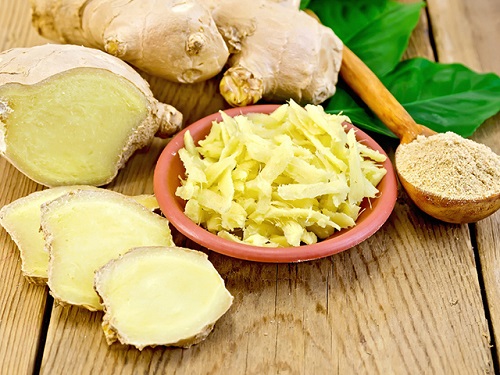
Ginger is a classic spice grown in many tropical and subtropical countries, from East Asia to Southeast Asia and South Asia. China, India, and Japan are the largest producers of ginger in the world.
In Vietnam, ginger is grown everywhere for food and medicine, for domestic use and for export.
Chemical composition
Ginger contains 2-3% of essential oil. It also contains oleoresin (5%), fat (3.7%), starches and spicy substance such as zingeron, zingerola and shogaola.
Ginger oil has a density of 0.878, boiling point 155 -300º. In the oil there is α camphen, β phelandren, a carbua: zingiberen C15H24, a sesquitecpen, a little bit of bocneola citrate and geraniola.
Uses
According to ancient documents: fresh ginger is spicy, has effects on the lungs, stomach, warm the body, cure vomiting, sputum, detoxification. Ginger used to cure the flu, abdominal fullness, vomiting, detoxification, cough phlegm. Dried ginger is spicy, warm, good for the heart, lungs, stomach, kidney and colon, for curing cholera, pain, cold hands, weak pulse, asthma, cough.
In the folk, ginger is a digestive aid, used in cases of poor eating, indigestion, vomiting, osteoporosis, cough, sweating, cough cure. Dosage is 3-6 g in the form of decoction or fresh ginger (2-5 ml daily). Can not use when cold, but abdominal pain, diarrhea, tired, vomiting.
Remedy with ginger:
- Headache, cold, vomiting, phlegm: fresh ginger 10g, licorice extract 4 g, 300 ml water, stew to 100 ml, divide many times a day, less drink when feel better .
- Cure vomiting: fresh ginger eat little by little until stop vomiting.
In addition to the use of spices, Coleus leaf essential oil is also used to treat flu, cough, sore throat, bloody cough, high fever, fever not sweating, vomiting blood, nosebleed.
General introduction
Coleus amboinicus, is a semi-succulent perennial plant in the family Lamiaceae with a pungent oregano-like flavor and odor.
Coleus amboinicus is a plant that grows up to 1 meter tall. The stem is flesh, either with long rigid hairs (hispidly villous) or densely covered with soft, short and erect hairs (tomentose). Leaves are fleshy, undivided (simple), broad, oval-shaped with a tapering tip (ovate). Flowers are on a short stem (shortly pedicelled), pale purplish in dense, 10-20 (or more) flowered dense whorls (cymes) at distant intervals in a long slender spike-like raceme. Small spherical, brown. The tree has very small feathers and fragrance like lemon.
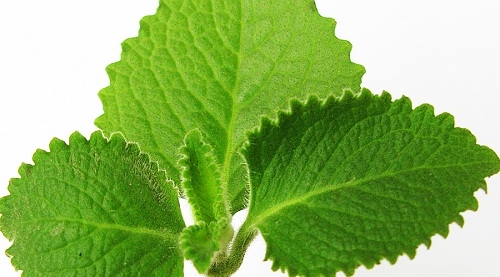
Coleus leaf essential oil is native to eastern India and Moluques Island, which is grown throughout Vietnam for leafy, pleasant aromas such as lemon, and used like spice.
Chemical composition
Coleus leaf essential oil leaves contain the major component is carvacrol 40-60%, in addition to α-terpinen, γ-terpinen.
Uses
There are not many studies on the pharmacological effects of lemon basil. In 1961, the Central Institute of Microbiology has studied the antibiotic effect of lemon basil essential oil for the Rudat method and found Coleus leaf essential oil has strong antimicrobial effect on Staphylococcus aureus, Salmonella typhi, Pseudomonas aeruginosa, Escherchia coli, Klebsiella, pneumoniae and Proteus species.
In addition to the use of spices, Coleus leaf essential oil is also used to treat flu, cough, sore throat, bloody cough, high fever, fever not sweating, vomiting blood, nosebleed. Usually use the leaves with a dose of 10-16 g per day, decoction, rinse or crush the drink. Cough syrup with lemon juice: Use 5-7 lemongrass leaves, wash in brine, then chew and lick. For young children, take freshly washed leaves, cut small with sugar, bring steamed rice and give 2-3 times a day.
Kumquat fruit is sour, slightly sweet, aroma, warmth, cough reduction effect, used as cough medicine.
General introduction
Kumquat’s scientific name is Citrus japonica Thumb
Small tree, not gai, 1-2m high, foliage is usually round beautiful. Leaves are Oval shape or tip, 4-8 cm long, 2-4cm wide, narrow at the base, pointed sometimes slightly concave, the original edges, smooth sides, veins prominently on the bottom, stem leaves about 1 cm long, no wings.
Flowers are white, fragrant, sprouting in the leaves, long with 5 triangular teeth, small feathers at the edges, 5 oval wings, shorter than the petals, attached at the base.
round fruit, not flattened at the two ends, when ripe red yellow, thin shell, very sour.
Flowering season in November and December, fruit season in January and February.
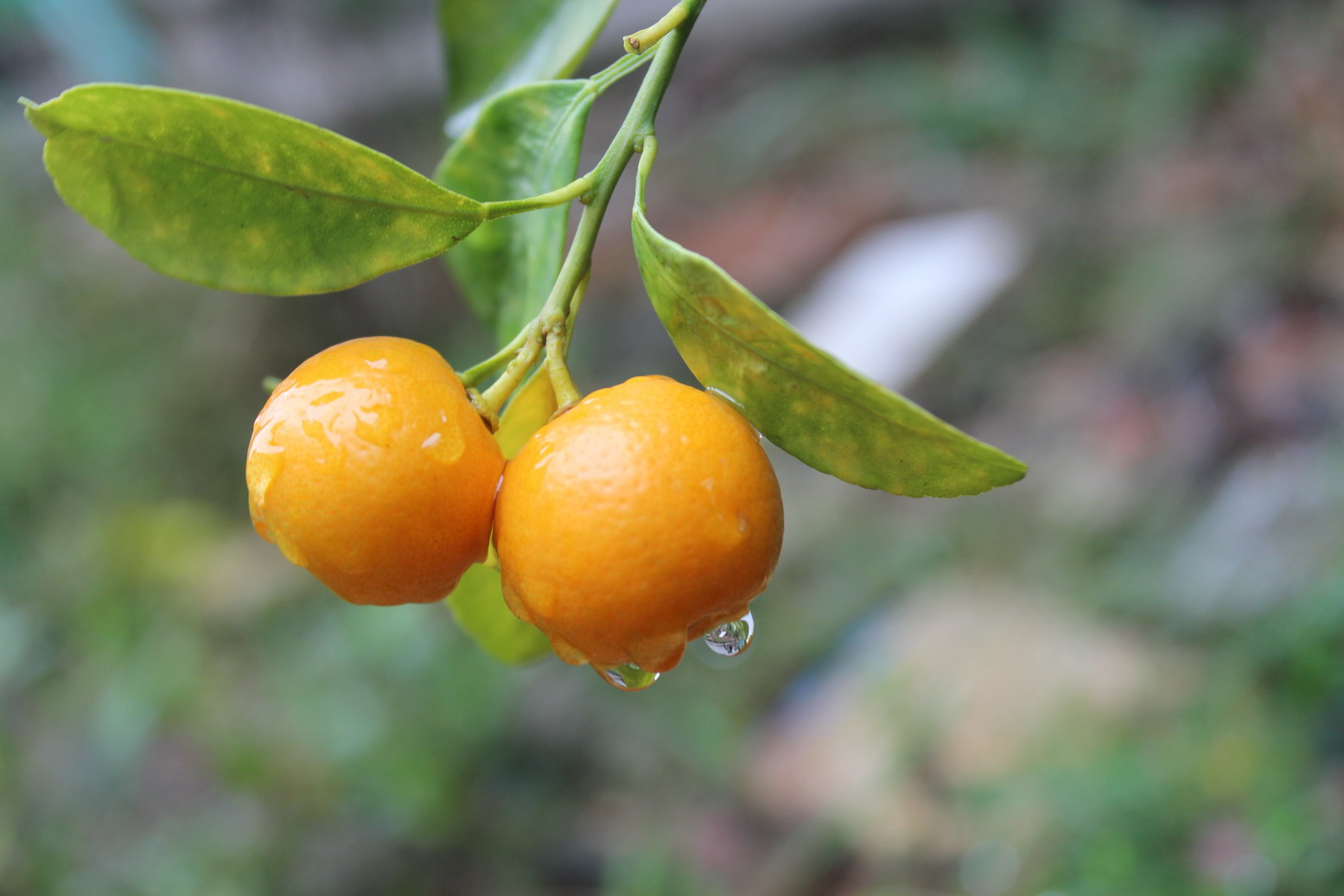
Kumquat originated in China and Japan, have been planted for a long time to make the scene and take the fruit. In Vietnam, it is grown mainly in the suburbs of Hanoi and neighboring provinces, which have been introduced in the south.
Kumquat is a branched, moist and light-loving species, growing and flourishing in the spring-summer, with annual flowers.
Chemical composition
Fruit contains more than 10% pectin (more in fruit shells), vitamin C 0.13-0.14%, Fe 5.1 mg / kg, Cu 0.8 mg / kg. Juice contain sugars, organic acids.
Shell fruit oil contains 25 components, including 2.8% α- pinene, 2.7% β-pinene, 88.4% limonene, 0.3% (E) -β- ocimene, trans- 0.2% linalool oxide, 1.5% linalool, 0.3% trans-pentadiene-2-ol-1-ol, 0.2% limonene oxide isomer, 0.4% carvone.
Uses
According to Western medicine, Kumquat essential oil is antibacterial. It effects on both Gram-negative bacteria (E. coli and S. typhimurium) and Gram-positive (S. aureus and B. cereus). According to oriental medicine, Kumquat essential oil stimulates respiration, loosen phlegm,
Remedy cough with kumquat:
10g ripe fruits, 10g white roses, 10g lemon seeds. Wash them in a bowl with some sugar or honey, and steam them for 15-20 minutes. Crushed, let cool, given to children 3 times a day during 3-4 days.
Melaleuca is used for colds, cough, asthma, chest pain, poor digestion, to increase blood circulation after delivery, rheumatism and painful nerves.
General introduction
Melaleuca leucadendra, commonly known as weeping paperbark, long-leaved paperbark or white paperbark is a plant in the myrtlefamilyy, Myrtaceae.
Melaleuca leucadendra is a large tree 10-20 m high or a low shrub about 0,5 m. Its thick bark is papery, usually white but also pinkish or cream and it has weeping branches. Its leaves and young branches are covered with fine, short, white hairs when young but become glabrous as they mature. The leaves are arranged alternately, 4-8 cm long, 1-2 cm wide, flat, narrow egg-shaped or lance-shaped and tapering to a point. The flowers are cream, white or greenish-white and are arranged in spikes on the ends of branches which continue to grow after flowering, sometimes on the sides of branches or in the upper leaf axils.

Melaleuca plant growing wild in Vietnam from the south to the north, most in the south, Melaleuca forests grow after extensive forests.
Vietnam is one of the largest natural cajuput forests in Asia. Each year can produce from 80 to 100 tons of essential oils, mainly for export. Melaleuca forests in Dong Thap Muoi also have big biological and environmental meaning.
Chemical composition
The main ingredient of Melaleuca leaves is essential oil with a rate of 2.5% (calculated on fresh leaves) or 2.25% (calculated on dried leaves). Melaleuca oil is a liquid, colorless or slightly yellowish (some are green because of dyeing, not natural color), pungency and cool, hot, special aroma. If refined, it clear, almost colorless, boil at 175ºC, dissolve in 2.5 to 3 volumes of alcohol 70ºC.
Composition of essential oil is cajeputol or xineola or eucalyptola in the rate of 35-60%. It also contains pinen, tecpineola, a few aldehydes (valeric, butyric, bezylic), and ethers such as acetic ether.
Refined oil will not contain andehyd. To refine melaleuca we can soak oil with a mixture of lead oxide and sodium hydroxide solution for 3 hours at a boiling temperature, or use potassium and sulfuric acid, and then re-stain. Refined melaleuca oil is not color or only very light yellow, pleasant aroma.
Uses
According to Western Medicine, Melaleuca oil has antibacterial effects: Staphylococcus aureus, Escherichia coli, Pseudomonas aeruginosa, Helicobacter pylori. It also has anti-fungal and anti-inflammatory, relieve pain, cough, cold and anti-inflammatory.
According to the research, Melaleuca oil has antimicrobial effect, anti-fungal and anti-inflammatory, analgesic. In the folk, Melaleuca oil is used to massage the skin to heal joint pain, limb aches. Melaleuca essential oil in castor oil with 5-10% rate use nasal decontamination, anti-influenza, stuffy nose. In traditional Indian medicine, diluted melaleuca oil is used to dilute the sputum in chronic laryngitis and bronchitis.
Eugenol is also very popular in dentistry (treatment of tooth inflammation, numbness, tooth erosion). In treatment of respiratory diseases, especially cough, Holy basil essential oil anesthetic throat should reduce throat irritation symptoms, sore throat.
Holy basil
Ocimum basilicum, commonly called basil, sweet basil or holy basil is an annual plant of the Ocimum genus belonging to the Lamiaceae family.
Ocimum basilicum is a perennial growing to 0.5 m (1ft 8in) by 0.3 m (1ft) at a fast rate, purple or smooth stems, usually branched from the root. Leaves have petiole, molars, reddish-brown color, feathers on both sides. Small, white or violet flowers growing into single or branched shoots with flowers growing in rounds of 5 to 6 flowers. The fruit contains black balls, when dipped in water it has white mucus surrounded. The tree smells fragrant.
Plants are native to India and China but are now grown in tropical and temperate countries of Asia, Europe (France, Germany, Italy, Spain and Russia).
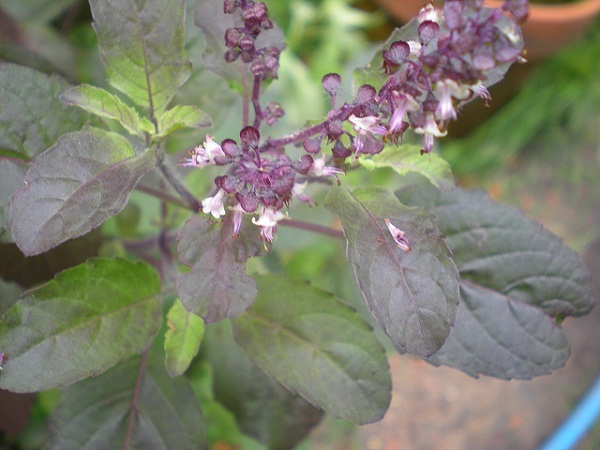
To make medicine, people just picked leaves and flowers (Herba Ocimi), dried or dried. To distill the oil, pick the whole tree, distill the fresh or distill it with distilled water.
Ingredient
Ocimum basilicum has 0.4 to 0.8% of essential oils. The oils are light yellow, aroma. The main components of the essential oils are eugenol, methyleugenol and b-caryophyllene.
Effect
According to research, eugenol oil has anti-inflammatory, antibacterial properties. It is used as a topical anesthetics, antiseptic against gangrene and tuberculosis. Gram-negative bacteria is affected by Holy basil essential oil include: Aeromonas hydrophila, Citrobacter freundii, Escherichia coli, Hafnia alvei, Klebsiella pneumoniae, Pseudomonas aeruginosa and Salmonella enteritidis.
Eugenol is also very popular in dentistry (treatment of tooth inflammation, numbness, tooth erosion). In treatment of respiratory diseases, especially cough, Holy basil essential oil anesthetic throat should reduce throat irritation symptoms, sore throat. With anti-inflammatory effect, Holy basil essential oil also reduce the risk of respiratory infections such as inflammation, bronchitis, ...
According to oriental medicine, Holy basil is pungent, warm. It is often used for colds, fever, headache, abdominal pain, vomiting, cramps. Use 6-12g of decoction each day.
Lemon essential oil is good for the immune system, enhancing the immune system. In addition, it has antibacterial properties that can help protect the body from infection.
Lemon
The scientific name is Citrus limonia Osbeck (Citrus medica L. subsp .limon Lour.), Belonging to the Rutaceae family.
The stem is small or smooth. The leaves are ovate or ovate, length 5.5-11 cm, width 3.5-6 cm, serrated leaves. Flowers are white, purple or redish purple. Flowers are alone or 2-3 flowers bunch. Small fruits are smooth and very sour.
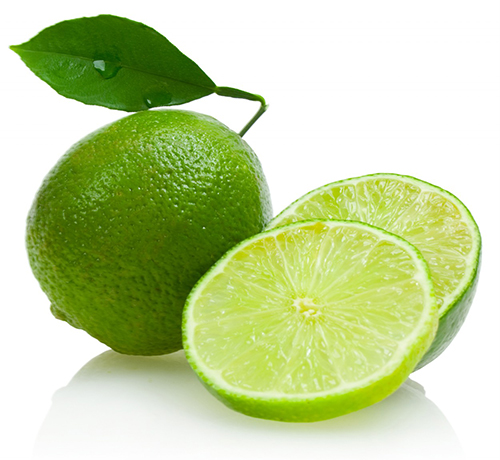
Ingredient
Lemon essential oil is about 0.2-0.6%, mainly extracted from the outer peel
In addition to essential oils, lemon peel also contains flavonoids such as neohesperidosides, rutinosides, hesperetin, naringenin and 44 other flavone-glycosides, carotenoids, organic acids such as citric acides, malic, and the metabolites of Coumadins.
Lemon essential oil contains about 90% Limonene, Terpinene, Phellandrene and Pinenne; About 4-6% of aldehydes such as Citral, Citronellal, Geranyl acetate and sesquiterpenes.
Lemon essential oil is light yellow or greenish yellow. It has the same smell as fresh lemon peel
Effect
Lemon essential oil is good for the immune system, enhancing the immune system. In addition, it has antibacterial properties that can help protect the body from infection. Prevent colds, cough, reduce sore throat. Bacteria is affected by lemon essential oils include: Pseudomonas aeruginosa, Salmonella typhimurium and Micrococcus aureus.
In eastern medicine, cinnamon has sweet taste, warmth, blood vessels, heart support, cold symptoms, coma, slow pulse, small, weak heart (vascular disease, hypotension) and critical cholera.
Cinnamon
The scientific name is Cinnamomum cassia Blume. Belonging to the Lauraceae. family.
Cinnamon is a perennial tree, in mature trees can be over 15m high, the diameter can reach 40cm. Cinnamon have single leaves grows or oppositifolious, the top of the leaves are green, the leaves are dark green, the leaves are about 18-20cm long, about 6-8cm wide, petiole about 1cm long. It has rounded trunk, gray outer shell
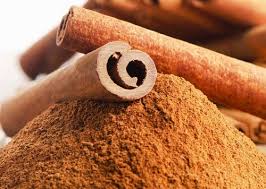
Ingredients
Parts of cinnamon trees such as bark, leaves, flowers, wood, roots contain essential oils, especially in the shell with the highest concentration of oil, sometimes reaching 4 - 5%. Cinnamon essential oil is yellow, the main component is Andean Cinamide, about 70 - 90%. Cinnamon essential oil is fragrant, spicy, sweet.
Effect
In eastern medicine, cinnamon has sweet taste, warmth, blood vessels, heart support, cold symptoms, coma, slow pulse, small, weak heart (vascular disease, hypotension) and critical cholera. . Cinnamon in Oriental medicine is one of four valuable drugs: Ginseng, Velvet, Cinnamon, Aconitum.
Cinnamon oil helps treat some respiratory diseases, stimulating blood circulation, making the body warm, anti-cold and antiseptic. Bacteria is affected by Cinnamon essential oil include: Streptococcus oralis, Streptococcus anginosus, Streptococcus intermedius and Streptococcus sanguis, Enterobacter aerogenes and Micrococcus roseus.